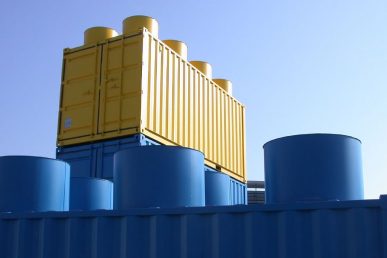In this post, I’m going to show you how to use Docker
Machine with
OpenStack. This is something I’ve been
interested in testing for a while, and now that I finally have my test
lab back up and running, I was able to spend some time on this. I’ll
spend some time later in the post covering my reasons for wanting to
look at this, but I’ll start with the technical content of how it works.
I tested this setup with the following components:
- The client system was running OS X 10.9.5 with the Docker 1.8.2
client binary and Docker Machine 0.4.1. - The OpenStack cloud was running the Juno release on Ubuntu 14.04
LTS, KVM hypervisors, and VMware NSX for networking.
There are (at least) two approaches to using Docker Machine and
OpenStack together:
- You can use Docker Machine’s
generic
driver to consume
already-provisioned OpenStack instances. This is, in large part,
very similar to what I covered
here, but I’ll
cover it in this post just for the sake of completeness. - You can use Docker Machine’s
openstack
driver to
automatically provision and configure new instances on an OpenStack
cloud. This is the more interesting approach, in my opinion.
Let’s take a look at each approach.
Using the Generic Driver
In this earlier
post, I showed how to use the Docker Machine generic driver with a Vagrant-managed local
VM. Using the generic driver with an existing OpenStack instance is
largely the same:
docker-machine create -d generic
--generic-ssh-user ubuntu
--generic-ssh-key ~/.ssh/openstack.pem
--generic-ip-address 192.168.100.1
dm-genericThis example is taken from using the generic driver to consume an
Ubuntu instance; hence, the value of “ubuntu” for the
--generic-ssh-user parameter. Obviously, you’d need to change values
around for your environment:
- You’ll need to replace the value of
--generic-ssh-userwith the
name of the default user for your cloud instance. - You’ll need to replace the SSH key specified in
--generic-ssh-key
to the correct key for your environment. - You’ll need to supply the correct IP address via the
--generic-ip-addressparameter. This will need to be an IP address
that is reachable from the system where you’re running Docker
Machine, so you might need to associate a floating IP address to the
instance first. - You’ll need to ensure that the instance’s assigned security groups
will allow SSH and Docker (TCP 2375 and TCP 2376) traffic.
Otherwise, Docker Machine will fail to communicate with the Docker
Engine.
Assuming you have all the right values, this will create a new engine in
Docker Machine that corresponds to an existing, already-provisioned
OpenStack instance. Note that this is super-simple in that it doesn’t
require any OpenStack-specific information—just the username, SSH key,
and IP address. You could provision these instances using a Heat
template, if you so preferred, and then prep them for use with Docker
using Docker Machine.
There’s a couple things to note about this:
- If the existing OpenStack instance already has the Docker Engine
installed, then Docker Machine will reconfigure the Docker Engine to
support remote use (enable listening on TCP port 2376 and
configure/enable TLS). - If the existing OpenStack instance doesn’t have the Docker Engine
installed, then Docker Machine will install Docker Engine and
configure it to support remote use (enable listening on TCP port
2376 and configure/enable TLS).
Note that I did run into a couple of odd issues using the official
Ubuntu 14.04.3 cloud image with Docker already installed. In this case,
Docker Machine rewrites the contents of /etc/default/docker, adding
(among other things) --storage-driver aufs. For whatever reason (I
haven’t yet been able to figure out why), this causes the Docker daemon
to crash. Only by removing --storage-driver aufs (and thus reverting
to the Device Mapper driver) was I able to make the Docker daemon run as
expected. For now, I’d recommend allowing Docker Machine to provision
the Docker Engine onto existing OpenStack instances, which worked
flawlessly in my testing.
Using the OpenStack Driver
As I mentioned earlier, I think this is actually the more interesting
approach to use (and I’ll discuss why farther down in this post). In
this approach, Docker Machine will launch an OpenStack instance on
behalf of the user and install/configure Docker on that instance.
Here’s the syntax for using the openstack driver for Docker Machine:
docker-machine create -d openstack
--openstack-username <OpenStack username of user>
--openstack-password <password of OpenStack user account>
--openstack-tenant-name <name of OpenStack tenant>
--openstack_auth_url http://<IP address of controller>:5000/v2.0
--openstack-flavor-id <ID of flavor to use>
--openstack-image-id <ID of image to use>
--openstack-net-name <name of private network>
--openstack-floatingip-pool <name of external network>
--openstack-ssh-user <default username>
--openstack-sec-groups <comma separated list of security groups>
<name>Wow…that’s quite a bit more complicated than using the generic driver!
You can simplify the command line a bit by setting some commonly-used
OpenStack environment variables:
- If you set
OS_USERNAMEyou can omit--openstack-username. - If you set
OS_PASSWORDyou can leave out--openstack-password. - If you set
OS_TENANT_NAMEthen you don’t need
--openstack-tenant-name. - If you set
OS_AUTH_URLyou don’t have to include
--openstack-auth-url.
Since you may have these environment variables already set for use with
the various OpenStack CLI clients, the OpenStack driver for Docker
Machine simply takes advantage of them.
However, you still need the rest of the command-line parameters, and
this requires a good deal bit more OpenStack-specific
knowledge/experience. You’ll need to determine the flavor ID (or name),
the image ID (or name), the floating IP pool in use, the name of the
Neutron network, and the name(s) of the security groups to use. All of
this information is easily accessible via the OpenStack CLI clients or
the OpenStack dashboard, but it’s still a lot of information to gather.
So what happens when you run this command?
- Docker Machine authenticates against OpenStack (using the URL,
username, password, and tenant specified in environment variables or
on the command line). - Docker Machine launches a new instance (using the image, flavor, and
network information) and associates a floating IP to the instance
(using the floating IP pool information). A new key is generated for
access to this instance. - Once the instance is accessible via SSH, Docker Machine connects to
the instance, installs Docker Engine, and configures it for remote
use (listens on TCP port 2375, enables and configures TLS).
The nice thing about doing it this way is that when you’re done,
docker-machine rm not only removes the local reference to the
instance, but also removes the instance from the OpenStack cloud. In
other words, it cleans up after itself.
(By the way, there’s nothing saying you can’t mix and match both the
generic driver and the openstack driver in the same environment.)
Why Docker Machine and OpenStack?
Some readers may be wondering why one might use Docker Machine in an
OpenStack environment. After all, doesn’t Docker make OpenStack
obsolete? (That was sarcasm, in case you didn’t notice.)
Here’s my line of thinking. OpenStack is really more of an
infrastructure orchestration tool, designed for provisioning
infrastructure (VMs, volumes, networks, routers, etc.). Will it evolve
over time to be more “application-aware”? Probably, but that’s not where
it is today. Docker, on the other hand, is more an an application
provisioning tool, designed to simplify how developers, operators, and
organizations deploy applications. Will it evolve over time to be more
involved in infrastructure? Most likely, but that’s not really where its
strengths are found today. Docker needs infrastructure, and OpenStack
supplies infrastructure. By combining Docker Machine and OpenStack, you
create what is (in my opinion) a nice “consumer/provider” relationship
between OpenStack (which provides infrastructure) and Docker (which
consumes infrastructure to deploy applications).
Anyway, that’s my two cents. I hope you found this information to be
helpful, and feel free to hit me up on Twitter or drop me an email if
you have any feedback. Thanks!
This post first appeared on Scott Lowe’s blog. You can also follow Lowe, an engineering architect at VMware, on Twitter at @scott_lowe. Superuser is always interested in how-tos and other contributions, please get in touch: [email protected]
Cover Photo by Josh Lackey // CC BY NC
- Exploring the Open Infrastructure Blueprint: Huawei Dual Engine - September 25, 2024
- Open Infrastructure Blueprint: Atmosphere Deep Dive - September 18, 2024
- Datacomm’s Success Story: Launching A New Data Center Seamlessly With FishOS - September 12, 2024

)










